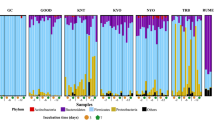Abstract
The establishment of microorganisms in the rumen is a critical step if rumen manipulation is to be accomplished by use of microbial inoculants. Microbial populations in the maturing rumen undergo successional changes and, while in a state of flux, provide a possible opportunity for the introduction of specific strains of bacteria. While the rumen of the young lamb was maturing, we measured changes in several microbial populations with 16S-rRNA specific oligonucleotides: Rumincoccus, Fibrobacter, eukaryotes, Gram-positive bacteria, the Bacteroides–Porphromonas–Prevotella group, and anaerobic rumen fungi. In this study we repeatedly dosed 15 lambs with approximately 3.4 × 108 to 0.8 × 109 Ruminococcus cells dose-1, twice a week, for 7 wk from 23 d to 63 d of age. Of the five Ruminococcus strains dosed (R. albus SY3 and AR67, and R. flavefaciens Y1, LP9155, and AR72) the most specific primers (based on 16S rDNA) were obtained for strain SY3. There was an increase in the eukaryotic population during dosing, and it was hypothesized that protozoal predation contributed to the disappearance of strain SY3. At the end of dosing PCR amplification showed that SY3 were approximately 109 cells ml-1, but decreased to below the detection limit of the PCR system (8.6 × 104 ml-1) within 28 d postdosing. These experiments showed that fibrolytic populations increased significantly (P < 0.1) above the controls during the dosing period and were elevated for several days postdosing. This suggests that dosing of highly fibrolytic bacteria makes more of the fiber available to other organisms able to degrade fiber, and in so doing increases the overall fibrolytic activity of the rumen. Examination of the succession of gram-positive bacteria and the Bacteroides–Porphromonas–Prevotella group showed a decline in relative abundance as the lambs matured.
Similar content being viewed by others
Author information
Authors and Affiliations
Additional information
Received: 13 April 1999; Accepted: 14 July 1999; Online Publication: 15 February 2000
Rights and permissions
About this article
Cite this article
Krause, D., Smith, W., Ryan, F. et al. Use of 16S-rRNA Based Techniques to Investigate the Ecological Succession of Microbial Populations in the Immature Lamb Rumen: Tracking of a Specific Strain of Inoculated Ruminococcus and Interactions with Other Microbial Populations in Vivo . Microb Ecol 38, 365–376 (1999). https://doi.org/10.1007/s002489901006
Issue Date:
DOI: https://doi.org/10.1007/s002489901006




